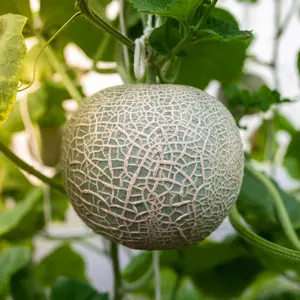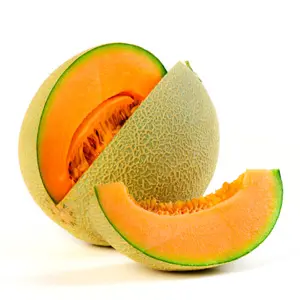This Hydrating Treat Could Be a Game-Changer for Your Pet
Despite being a summertime favorite, this round-shaped fruit can be enjoyed any time of the year. Here's a tip — Slice it into small pieces and try giving it as a training treat for your pet!

STORY AT-A-GLANCE
- Cantaloupe is a healthy fruit that’s low in calories and high in water content, which makes it a great treat for rehydrating your pet
- It’s rich in ascorbic acid, carotene, folic acid and potassium as well as a number of other human health-bioactive compounds
- Cantaloupe contains bioactive nutrients that may help support your pet’s eyesight, namely xanthophyll, lutein and zeaxanthin. One study that evaluated these nutrients in various tropical fruits noted that cantaloupe is one of the richest sources of these nutrients
- This fruit is best given to pets raw — just cut it up in small pieces (appropriate for your pet’s size) and add to their species-appropriate, nutritionally adequate meals as a topper, or give it as a healthy treat
- The tough, fibrous rinds can trigger gastrointestinal upset or become a choking hazard, so only feed the edible parts of fruits and veggies to your family members
Editor's Note: This article is a reprint. It was originally published July 27, 2022.
Cantaloupe (Cucumis melo var. cantalupensis) is a member of the Cucurbitaceae family, along with summer and winter squash, gourd, pumpkin, watermelon and cucumber.1 A delicious, juicy slice of this fruit can be a refreshing and delightful snack any time of the year, but did you know it can be a good treat to share with your pets as well?
With its mild sweetness and high water content, lots of animals enjoy sinking their teeth into cantaloupe. Here’s what you need to know when feeding this fruit to your pets.
Did You Know?

“Cantaloupe” came from the name “Cantalupo,” a province in Italy where this fruit was first cultivated during the 1700s. In Australia, it’s called a “rockmelon.”2
Cantaloupe Is Loaded with Bioactive Antioxidants
Cantaloupe is a healthy fruit that’s low in calories and high in water content, which makes it a great treat for rehydrating your pet. One study notes it’s rich in ascorbic acid, carotene, folic acid and potassium as well as a number of other human health-bioactive compounds.3 The bioactive compounds referred to are the phytochemicals found in the fruit, which include polyphenols, carotenoids and flavonoids.4
Polyphenols in particular are known for their antioxidant activity, helping to delay or inhibit lipid oxidation, which protects cells against free radical damage. This is crucial in preventing diseases like cancer and cardiovascular disorders.5
Carotenoids, on the other hand, are the lipid-soluble pigments that give fruits and vegetables their color, and have therapeutic benefits such as anticancer, anti-inflammatory, antidiabetic, antibacterial and neuroprotective properties.6 As for flavonoids, these compounds may help promote animals’ growth and development.7
Cantaloupe also contains bioactive nutrients that may help support your pet’s eyesight, namely xanthophyll, lutein and zeaxanthin. One study that evaluated these nutrients in various tropical fruits noted that cantaloupe is one of the richest sources of these nutrients. According to the researchers:8
“[T]he consumption of fruits and vegetables with rich [content] of xanthophyll, lutein and zeaxanthin is associated with a lower problem of cancer, cardiovascular disease, age related macular degeneration (ARMD) and cataract formation.”
This Fruit Also Offers Vitamin C and Folate
While dogs can synthesize their own vitamin C in their bodies, getting supplementary amounts of this nutrient from food can be good for their health as well, and cantaloupe is one of the best sources. A 1-tablespoon serving can give your pet 1.08 milligrams of this free radical-scavenging nutrient,9 which may play a role in reducing inflammation and cognitive aging.10
Another vitamin that is abundant in cantaloupe is folate (or vitamin B9). A 1-tablespoon serving can give your pet 1.4 micrograms of this nutrient,11 which acts as a coenzyme that is crucial for various processes, such as immune function, blood formation, tissue growth and cell division.12 It also plays a role in fetal health among animals. One study noted that puppies born to female pugs and chihuahuas that received folic acid supplementation during their pregnancy had a lower risk of getting lip and/or palate cleft (CL/CP).13
Cantaloupe vs. Muskmelon — What’s the Difference?

“Muskmelon” is a term that describes melons that have a sweet fragrance and flavor, and the cantaloupe falls under this category, along with other varieties like canary melons and honeydew. So basically, all cantaloupes can be called muskmelons, but not all muskmelons can be called cantaloupes.14
Cantaloupe Contains an Antiparasitic Compound
Cucurbitacins, which are found in melons and vegetables like cucumber, are naturally occurring triterpenes that are used by the plant as a defense mechanism against diseases.15 Interestingly, in human health, this compound has shown promise for its antitumor properties.16
In domestic animals, cucurbitacin may hold potential in helping eliminate parasites due to its anthelmintic properties. One study noted that extracts from pumpkin seeds, which also have cucurbitacin, “displayed high anthelmintic efficacy” in study rats.17
Top Cantaloupe-Producing Countries Worldwide

Most of the world’s cantaloupes come from China — it produces nearly 50% of the overall supply of this fruit. Turkey comes next, with 6.06%, followed by India, with 4.67%.18

How to Give Cantaloupe to Your Pets
Misinformation about many healthy fruits, vegetables, nuts and seeds abounds on the internet. This is because websites have labeled all risks (such as the risk of overconsumption causing gastrointestinal issues, or choking on too large of pieces or pits) as "toxicities," which isn't true but has managed to confuse millions of pet lovers, nonetheless.
In the case of cantaloupe, this fruit is best given to pets raw and in small pieces, as large chunks can pose a choking hazard — just cut it up in small pieces (appropriate for your pet’s size) and add to their species-appropriate, nutritionally adequate meals as a topper, or give it as a treat. Just make sure that all treats constitute less than 10% of their daily caloric intake.
“Just as you wouldn’t eat cantaloupe rind, make sure not to give it to your pet either.”
According to the American Kennel Club, the tough, fibrous rinds can trigger gastrointestinal upset or become a choking hazard.19 Obviously, only feed the edible parts of fruits and veggies to your family members, including your pets; never offer pits or rinds. Cantaloupe is safe for cats, and this is one fruit that many cat lovers say their felines show an interest in consuming.
Is Cantaloupe Sustainable?
Cantaloupe is relatively sustainable and has a low water and carbon footprint.20 It ranks No. 12 in the Environmental Working Group’s (EWG) Clean Fifteen list, meaning it’s safe to buy conventional.21 Due to the fruit’s thick skin and rind, the possibility of the flesh being contaminated with pesticides is likely low as well. However, it may be best to look for organic or spray-free cantaloupe to make sure you’re getting high-quality food without the toxic burden.
Sources and References
- 1 PennState Extension, February 16, 2021
- 2 Wisconsin Department of Public Instruction, Cantaloupe
- 3 International Food Research Journal 19(4): 1621-1628 (2012), Introduction (Archived)
- 4, 5 Foods. 2019 Jun 6;8(6):196. Introduction
- 6 Animal Physiology and Animal Nutrition, Volume 104, Issue 6 November 2020, Pages 1809-1818
- 7 Arch Animal Husb & Dairy Sci. 1(1): 2018
- 8 2012 International Conference on Nutrition and Food Sciences, Level of Xanthophyll, Lutein and Zeaxanthin in Selected Thai Fruits, Introduction
- 9, 11 USDA FoodData Central, Melons, Cantaloupe, Raw
- 10 American Kennel Club, March 14, 2024
- 12 My Pet Nutritionist, June 30, 2021
- 13 Pol J Vet Sci. 2013;16(1):33-7
- 14 Spoon University, July 14, 2018
- 15 Canadian Academy of Sports Nutrition, Cucurbitacins
- 16 The Horticulture Journal, January 2019, Volume 88, Issue 2, Pages 253-262
- 17 Journal of Pharmacognosy and Phytotherapy Vol. 7(9), Pages 189-193, September 2015
- 18 Tridge, Global Production of Cantaloupe
- 19 American Kennel Club, July 9, 2024
- 20 Shop Logic, January 2, 2025
- 21 EWG, 2024 Shopper's Guide to Pesticides in Produce™, Clean Fifteen











